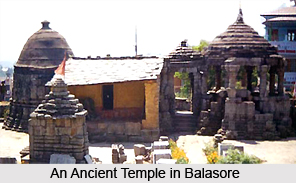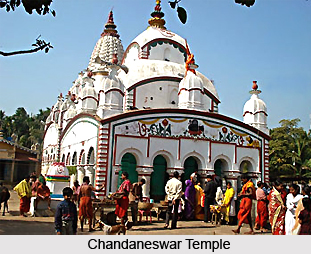 Monuments in Balasore comprise of a number of Hindu temples, Buddhist monuments, British graves, etc. The district of Balasore in the state of Orissa is situated at a distance of two hundred and thirty one kilometers to the south of Kolkata along the route to Chennai from West Bengal. Previously a place of immense commercial importance, it was one of the earliest English settlements in India. Located on the shore of the River Budhabalanga, Balasore was the ancient hub of marine activity during the medieval times in Orissa state, known as Kalinga at that time. The district has also experienced the arrival of the French and the Dutch on the shores of Orissa. The marks of the arrival of these foreigners and the traces of their conquests are still there to be seen in Dinamardinga and Farasidinga parts of Balasore.
Monuments in Balasore comprise of a number of Hindu temples, Buddhist monuments, British graves, etc. The district of Balasore in the state of Orissa is situated at a distance of two hundred and thirty one kilometers to the south of Kolkata along the route to Chennai from West Bengal. Previously a place of immense commercial importance, it was one of the earliest English settlements in India. Located on the shore of the River Budhabalanga, Balasore was the ancient hub of marine activity during the medieval times in Orissa state, known as Kalinga at that time. The district has also experienced the arrival of the French and the Dutch on the shores of Orissa. The marks of the arrival of these foreigners and the traces of their conquests are still there to be seen in Dinamardinga and Farasidinga parts of Balasore.
Balasore, also called Baleshwar or Baleswar, is a purposefully situated city in Orissa in the eastern parts of India. It also serves as the administrative headquarters of the district of Balasore. The city is famous for the beach at Chandipur, which is where the Indian Ballistic Missile Defense Program`s Integrated Test Range is situated. It is exactly at a distance of seventy kilometers to the south of Chandipur. The Defense Research and Development Organization prepared several missiles like Brahmos, Nag, Agni, etc here.
In the seventeenth century, the city of Balasore in the southern parts of Bengal was considered to be the prominent trading centers of the entire region. The Balasore town is situated at a distance of fifteen kilometers to the west of the Indian Ocean and is linked by the River Burhabalang with the sea. The region`s importance rose mainly after the eviction of the Portuguese from Hooghly and prior to the foundation of Kolkata.
The Portuguese and the Dutch VOC, the Danish and the British East India Company and the French set up factories here. Mainly textiles, saltpeter, salt or rice were exported, whereas cowries, silver, lead and copper were the most important commodities which were imported. Trade in this part however decreased in the eighteenth century because of the increase in competition from Kolkata and various other trading settlements in Bengal. The trade of Danish at Balasore was already interrupted in the decades of the thirty years war, again during the end of the seventeenth century and lastly abandoned in the Napoleonic Wars. When the troops of the British ventured into the Scandinavian factory in the year 1808, nothing of major importance was left there.
 Some of the major monuments in Balasore include the rich sculptural remains found in Ayodhya. The ruin of the old Buddhist monastery and temple is there in Kupari in Balasore. The image of Lord Buddha was also excavated in Balasore at Solampur and Soro and Khadipada, where several scattered images remain. Some of the ruined forts at the Jayachandi forests in Raibania located at a distance of seventy five kilometers from Balasore. The major religious monument is the Lord Chandaneswar Shrine and close to it is the beach at Talasari.
Some of the major monuments in Balasore include the rich sculptural remains found in Ayodhya. The ruin of the old Buddhist monastery and temple is there in Kupari in Balasore. The image of Lord Buddha was also excavated in Balasore at Solampur and Soro and Khadipada, where several scattered images remain. Some of the ruined forts at the Jayachandi forests in Raibania located at a distance of seventy five kilometers from Balasore. The major religious monument is the Lord Chandaneswar Shrine and close to it is the beach at Talasari.
The well-renovated burial ground in Balasore district is the Cemetery of Dinamardinga, possessing some of the British graves encircled by a metal fence. This is one of the best examples of the burial ground of a small European settlement in its classicistic shape with tum-bas, pyramids, pavilions and columns. Although the British officially bought the Danish factory ground only in the year 1845, they had already started to use it as a cemetery since the year 1808 as evident from the inscriptions, straightaway after the capture of the Danish factory by the British East India Company troops in the Napoleonic Wars. There is a single tombstone, which might be brought from another place, from the eighteenth century is left, belonging to the seventeen year old Isabella Kelsall who died twelve years prior to the recapture of the factories by the Danes. Two Danes were buried in Balasore; the Danish resident Carl Adolph Heyberg died in the 1st of August 1797, and his successor Kofoed who served there for four month till his surprising death. It is assumed that some of the tombstones not having any inscriptions belong to the Danes.
One can find behind the present Girl`s High School in Balasore, two notable pyramids dating back to the seventeenth century inside a fully-neglected garden, one of the Michiellians Burggraaf van Sevenhuisen who expired in the year 1696. The huge shape and dimensions are unique with regard to the seventeenth century Dutch monuments in India.
Mr. Gabriel Broughton, the surgeon of the ship Hopewell, healed the daughter of the emperor, whose clothes had caught fire in the year1636, and later in the year 1640, he successfully treated one of the ladies of the zenana. He obtained as a reward the right for the English to set up a maritime station in Bengal. In the year 1634, the first factory was established at Pippli but later, in the year 1642 it was shifted to Balasore, to be joined by rival Dutch, Danish and French factories. Afterwards, the port silted up and was superseded by Kolkata. In a small compound near the town are some fine early Dutch tombs, constructed in the year 1683 in the form of three-sided pyramids having six meter height. Thus, the ancient rulers of the land have suitably left a mark on the architecture of Balasore with the construction of innumerable monuments, temples and beautiful picturesque locations.



















